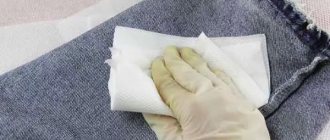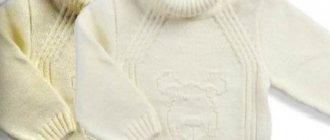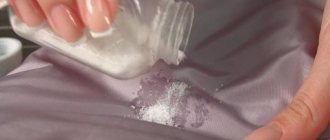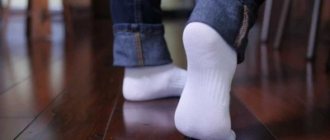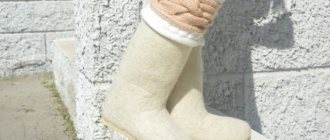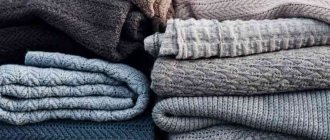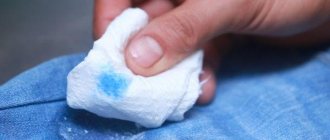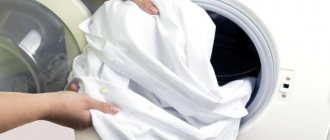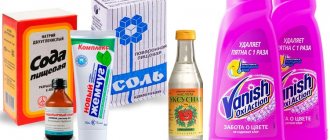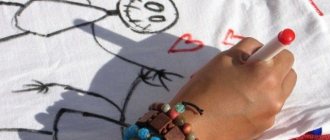What to do if things are stained. First measures
Any item of clothing can fade . Washing new wardrobe items, clothes made from bright fabrics, wool or denim can cause unwanted staining. Proper organization of washing and distribution of items helps reduce the risk of damage.
If such a situation occurs, do not panic.
The product can be saved if you immediately use proven methods:
- Boiling. Under the influence of high temperature, the paint is washed out of the fabric. This is one of the most effective methods, but it is not suitable for all types of fabric. Some materials may become deformed.
- Repeated washing . It is necessary to remove all things that can shed. It is better to wash the item of clothing separately. Active powder and the maximum temperature allowed by the tag on the clothing will help restore the original appearance of the products.
- Bleaching . This method is only suitable for white products.
Advice! It is important to act quickly and immediately after painting. Drying your clothes and ironing them will cause the dye to bond even more firmly into the fibers of the fabric. After this, it will be much more difficult or simply impossible to remove it.
We use special equipment
Home remedies can help remove faded stains, but only if used immediately after dyeing. If stains are noticed late, then specialized products and stain removers will come to the rescue.
The following household chemical products can be found on sale:
- "Antilin." Designed specifically to get rid of stains that appear as a result of shedding. It is effective for different types of fabric, but may slightly change the original color of the product.
- "Vanish." Helps restore whiteness not only to light-colored items, but also to remove difficult stains from colored items.
- Bleaches for light-colored items marked White . It is worth choosing the right product depending on the type of fabric.
- Korean products Paracle and Oxi Clean. Excellent for removing fade stains from brightly colored fabrics.
- Pasta Dr. Beckmann 3 in 1 . The product is applied using a sponge and is suitable for all types of fabrics.
Be sure to read:
How to bleach nylon tulle from gray and yellowness, the best way, reviews
Technology for washing black and white items
If you initially wash, clean and dry black and white items correctly, then they will not need to be restored in the future. The main rule of the approach is only manual processing. The washing machine does everything quickly, but in this case its use is excluded.
The manual processing process is also not so simple; the following rules must be observed:
- We pour warm water into the basin; its temperature should not exceed 30ºC, otherwise you can’t count on preserving the color. We dissolve the washing gel in the liquid; after the powder, stains often remain on the black background.
Advice: Before using a new product, you need to make sure that it does not contain bleaching components; they will definitely ruin a specific item.
- Mechanical processing of contaminants must be kept to a minimum, otherwise the dark paint will transfer to the white elements. It is better to change the soaking solution several times to wash stains out of the fabric.
- After the dress can be washed, you need to fix the color of the product. Vinegar is traditionally used for this. Dilute a tablespoon of 9% solution in a liter of cold water. We rinse the clean product in the resulting mixture, gently squeeze it out and send it to dry.
If, after approaching, you are unable to get rid of the stains, you should not immediately re-wash the item of clothing. You need to select a stain remover depending on the color of the contaminated fabric and use it strictly locally.
We recommend: How to wash pens from clothes - useful tricks
How to bleach white clothes
White items require careful care. If white clothes are stained as a result of an unsuccessful wash, you should choose a cleaning method based on the type of fabric and care instructions on the item's label.
Natural fabrics
Items made from natural fabric must be washed again.
If stains remain, you can resort to the following methods:
- Boiling. White things are placed in a saucepan and boiled for 2-3 hours.
- Soaking in ammonia. For 5-6 liters of water take 1 glass of alcohol. It is enough to keep things in the solution for 1 hour.
- Soaking with hydrogen peroxide. Similarly, add 50 ml of peroxide to 5 liters of water and pour things in for 1 hour.
- A mixture of starch, lemon juice and salt. The ingredients are mixed in equal parts and diluted in a container with water until it becomes thick sour cream. Treat the stains with the resulting mixture and rinse thoroughly after half an hour.
- Potassium permanganate. The item should be soaked in a weak solution of potassium permanganate for 20-30 minutes.
Synthetic fabric
Synthetic clothing requires delicate care and does not tolerate too high temperatures, bright sunlight and chlorine-based chemicals.
To get rid of stains on synthetic items, you can use:
- Ammonia, laundry soap and hydrogen peroxide. Mix 5 tbsp. l. alcohol, 1 piece of soap and 2 tbsp. l. peroxide, dilute the ingredients in 10 liters of water. Soak the soiled wardrobe items in the resulting solution for 30 minutes. and rinse.
- Aspirin. 2 tablets are diluted with 1 glass of water and moistened with soiled areas. After 5 min. the item is washed in the usual way.
- Laundry soap. The damaged item must be immediately thoroughly soaped and soaked for several hours, then washed in the usual way.
Delicate items
The following methods are suitable for cleaning items made from delicate fabrics:
- Washing powder, ammonia, salt and hydrogen peroxide. Add 1 tbsp to 5 liters of water. l. each ingredient and soak the dyed items in the solution. After a couple of hours, the laundry should be rinsed well.
- Dry mustard (1 tbsp) is diluted in 1 liter of hot water. The mixture is infused for a couple of hours, then contaminated items are washed in it.
Be sure to read:
How to whiten a white blouse: 7 folk recipes if it has turned gray or yellowed
How to remove stains on colored items
On some colors the stains are almost invisible. If you don’t know how to restore color to colored items and refresh the brightness, use the methods below. Remember, if a denim jacket or pants have faded, you cannot “reanimate” the clothing. Only re-dyeing will give things “new life”.
Using a soap-salt solution
The following recipe will help return clothes to their original color:
- Take 125 g of coarse salt, pour into a container for soaking;
- Add grated soap (laundry soap) and potato or corn starch (1 tbsp);
- Stir in lemon juice;
- Apply the prepared mixture to the stains, leave for several hours or overnight;
- Then rinse without wringing and hang to dry.
The method copes well with stains and stains, especially on white things.
Professional products
Use stain removers marked “Color”, otherwise the fabric will be damaged even more. It is better to choose products containing oxygen, for example, Vanish. They cope better with stains, restore fibers, and do not damage colored materials. There are rules for using stain removers. Gels or powders are added to warm water; three caps are enough. The laundry is left in the solution for several hours, then rinsed and dried. Usually, after the first time, all stains, stains and other contaminants disappear.
Restoring color with green tea
We use high quality tea bags. Making an infusion is easy. Pre-chill the bag in the freezer overnight. Then boil 4 liters of water, put chilled tea in it, turn off the stove. Clothes are left in the drink for 4 hours, rinsed, and washed with the addition of the usual powder.
Peroxide and ammonia
You must choose pure alcohol to get the desired effect. Homemade stain remover is prepared as follows:
- Take 4 liters of water and pour it into a metal container.
- Add 1 tsp of ammonia, 2 tbsp of peroxide 3%.
- Damaged products are dipped into the resulting mixture.
- Place on the stove, bring to a boil, and leave for an hour.
- Then the clothes are rinsed with slightly warm water and hung out to dry.
During the boiling process, the excess paint will evaporate along with the alcohol, leaving behind a clean item without stains or streaks.
How to use bleach
Bleach is effective, but when using it you need to take into account some rules:
- it is better to apply them only to natural fabrics; when bleaching artificial materials, they may be useless,
- preference is given to bleaches that contain oxygen, since they are more effective and gentle,
- when washing by hand, it is recommended to pre-soak items with bleach for 6-8 hours,
- washing by machine is allowed if it is not prohibited by the tag on the clothes; when washing in a machine, it is better to use bleaches in the form of gels,
- on dense fabrics, treat problem areas with bleach, leave for 10-15 minutes, then wash.
How to restore colored clothes
Items made from colored fabrics are usually washed together, so they suffer from shedding more often. Measures to restore their appearance also depend on the type of fabric.
Natural fabrics
The following methods are effective:
- Repeated wash on intensive cycle . Dyed clothing should be washed again at a higher temperature (if allowed on the tag) and with more detergent. So the thing will paint over itself.
- Ammonia. For 10 liters of water take 1 tbsp. l. substances. The item of clothing is soaked for 20 minutes, boiled and rinsed well.
- Washing powder with hydrogen peroxide. 50 g of powder is combined with 15 ml of peroxide and diluted with water. Soak the damaged item in the mixture for an hour and rinse.
Synthetic clothing
Help in cleaning items made from synthetic fabrics will be provided by:
- A mixture of lemon juice, starch and laundry soap . The ingredients are mixed in equal parts and applied to areas of contamination. After a couple of hours, the clothes are washed in the usual way.
- Repeated rinsing in clean water. Effective for fresh stains.
Delicate clothing
To remove stains from colored delicate fabrics, you can use a mixture of baking soda and vinegar. A tablespoon of baking soda is quenched with vinegar and applied to the stain. After an hour, rinse thoroughly.
Be sure to read:
How to wash towels: effective ways to bleach and clean terry materials
Whitening at home
The choice of method for bleaching a white pattern on colored knitwear will depend entirely on the quality of the fabric, as well as the pattern itself. Most often, when making prints on T-shirts, sublimation or film printing is used. In this case, there is nothing to be afraid of - even with direct contact with bleach, the drawing should retain its original appearance. You can safely use any chemical to bleach knitwear of this quality and not worry about the end result.
Related links: What is brick-effect decorative stone and how to use it in the interior
Important! It is strictly not recommended to boil T-shirts and T-shirts of this type; there is a high probability of film and paint peeling off.
Also, do not use optical brighteners for such localized areas. Such products can remove multi-colored fibers from the fabric of products.
You don’t have to worry about designs applied to fabric using stamping or screen printing. They tolerate the bleaching procedure well; the paints of the design can withstand even the most severe effects of high-temperature chemistry. And determining the method of applying the design is not difficult; you just need to turn the product inside out. If there is no mirror image of the front design on the reverse side, then you can be sure that it was applied only to the front part using the stamping or stencil method. Feel free to choose any bleach that is suitable for this type of fabric.
Related links: How to decorate a bedroom in Provencal style
For products with a pattern applied using thermal printing, it is important to choose the correct bleaching method. With the thermal printing method, the paint penetrates deeply into the fabric and is able to adhere quite firmly for a long time.
Items with embroidery and various decorations are strictly prohibited from being placed in hot water. Such products are washed mainly by hand and only with special means:
- Oxygen. It consists of peroxide and soda, and upon contact with water it begins to release oxygen. It eliminates foreign odors well and removes dirt well.
- Optic. Thanks to the reflective particles, there is a white effect. They cover the entire surface of the product. It is unlikely that it will be possible to return the original appearance, but the item will definitely be fresher.
For dark clothes with white patterns, it is better not to use any bleach. The drawing may lose its outline and brightness, and the dark side will be completely ruined.
How to prevent staining
It is easier to follow the washing rules than to later remove stains from faded fabrics.
To avoid possible staining, the following washing recommendations should be followed:
- Wash white and colored items separately,
- do not combine washing items of clothing of radially different colors,
- do not wash clothes that are susceptible to shedding at high temperatures,
- wash new items separately,
- When washing in a machine, add color catchers or special dye fixing agents.
